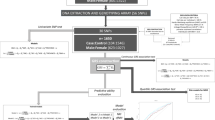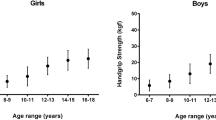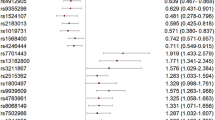Abstract
Genome-wide association studies (GWAS) in adults have identified single nucleotide polymorphisms (SNPs) associated with systolic blood pressure (SBP), but it is unclear whether the findings apply in youth. Further, the role of body mass index (BMI) in these associations is understudied. Our objective was to determine whether BMI modifies genetic susceptibility to high SBP in young people. The sample comprised 714 participants of European ancestry recruited in 1999–2000 from 10 Montreal-area high schools for a longitudinal study. SBP was measured at ages 12, 15, 17, 24, and 30. Blood and saliva samples were collected at ages 14, 20, and 25. Two evidence-based genetic risk scores (GRS) were constructed based on GWAS results in adults: GRS22 used 22 SNPs and GRS182 added 160 additional SNPs to GRS22. Sex-specific associations between each GRS and repeated measures of SBP were estimated using linear mixed models including BMI and a GRS*BMI product term. GRS182 explained a greater proportion of SBP variance than GRS22, and a greater proportion in females than males. The associations increased monotonically with BMI values between 22 kg/m2 and 35 kg/m2. Results indicate that BMI modifies the association between a GRS and SBP levels from adolescence to adulthood.
This is a preview of subscription content, access via your institution
Access options
Subscribe to this journal
Receive 12 digital issues and online access to articles
$119.00 per year
only $9.92 per issue
Buy this article
- Purchase on SpringerLink
- Instant access to full article PDF
Prices may be subject to local taxes which are calculated during checkout



Similar content being viewed by others
Data availability
The datasets generated during and/or analyzed during the current study are available from the corresponding author upon reasonable request. Access to NDIT data is open to any university-appointed or affiliated investigator upon successful completion of the application process. Masters, doctoral and postdoctoral students may apply through their primary supervisor. To gain access, applicants must complete a data access form available on our website (www.celphie.ca) and return it to the principal investigator (jennifer.oloughlin@umontreal.ca). The procedure to obtain access to NDIT data is described in O’Loughlin, J., Dugas, E. N., Brunet, J., DiFranza, J., Engert, J. C., Gervais, A., Gray-Donald, K., Karp, I., Low, N. C., Sabiston, C., Sylvestre, M. P., Tyndale, R. F., Auger, N., Belanger, M., Barnett, T., Chaiton, M., Chenoweth, M. J., Constantin, E., Contreras, G., Kakinami, L., Labbe, A., Maximova, K., McMillan, E., O’Loughlin, E. K., Pabayo, R., Roy-Gagnon, M. H., Tremblay, M., Wellman, R. J., Hulst, A., Paradis, G., 2015. Cohort Profile: The Nicotine Dependence in Teens (NDIT) Study. Int J Epidemiol. 44(5), 1537–1546. doi: 10.1093/ije/dyu135.
References
Forouzanfar MH, Liu P, Roth GA, Ng M, Biryukov S, Marczak L, et al. Global burden of hypertension and systolic blood pressure of at least 110 to 115 mm Hg, 1990-2015. JAMA. 2017;317:165–82.
Yang L, Magnussen CG, Yang L, Bovet P, Xi B. Elevated blood pressure in childhood or adolescence and cardiovascular outcomes in adulthood: a systematic review. Hypertension. 2020;75:948–55.
Flynn JT, Kaelber DC, Baker-Smith CM, Blowey D, Carroll AE, Daniels SR, et al. Clinical practice guideline for screening and management of high blood pressure in children and adolescents. Pediatrics. 2017;140:e20171904.
Chen X, Wang Y. Tracking of blood pressure from childhood to adulthood: a systematic review and meta-regression analysis. Circulation. 2008;117:3171–80.
Shi Y, de Groh M, Morrison H. Increasing blood pressure and its associated factors in Canadian children and adolescents from the Canadian Health Measures Survey. BMC Public Health. 2012;12:388.
Statistics Canada. Canadian Health Measures Survey, 2015–2019. https://www23.statcan.gc.ca/imdb/p2SV.pl?Function=getSurvey&SDDS=5071. (2019).
Ehret GB, Munroe PB, Rice KM, Bochud M, Johnson AD, Chasman DI, et al. Genetic variants in novel pathways influence blood pressure and cardiovascular disease risk. Nature. 2011;478:103–9.
Evangelou E, Warren HR, Mosen-Ansorena D, Mifsud B, Pazoki R, Gao H, et al. Genetic analysis of over 1 million people identifies 535 new loci associated with blood pressure traits. Nat Genet. 2018;50:1412–25.
Kurniansyah N, Goodman MO, Khan AT, Wang J, Feofanova E, Bis JC, et al. Evaluating the use of blood pressure polygenic risk scores across race/ethnic background groups. Nat Commun. 2023;14:3202.
Juhola J, Oikonen M, Magnussen CG, Mikkila V, Siitonen N, Jokinen E, et al. Childhood physical, environmental, and genetic predictors of adult hypertension: the cardiovascular risk in young Finns study. Circulation. 2012;126:402–9.
Petkeviciene J, Klumbiene J, Simonyte S, Ceponiene I, Jureniene K, Kriaucioniene V, et al. Physical, behavioural and genetic predictors of adult hypertension: the findings of the Kaunas Cardiovascular Risk Cohort study. PLoS ONE. 2014;9:e109974.
Kauko A, Aittokallio J, Vaura F, Ji H, Ebinger JE, Niiranen T, et al. Sex differences in genetic risk for hypertension. Hypertension. 2021;78:1153–5.
Xi B, Shen Y, Zhao X, Chandak GR, Cheng H, Hou D, et al. Association of common variants in/near six genes (ATP2B1, CSK, MTHFR, CYP17A1, STK39 and FGF5) with blood pressure/hypertension risk in Chinese children. J Hum Hypertens. 2014;28:32–36.
Xie T, Wang B, Nolte IM, van der Most PJ, Oldehinkel AJ, Hartman CA, et al. Genetic risk scores for complex disease traits in youth. Circ Genom Precis Med. 2020;13:e002775.
Oikonen M, Tikkanen E, Juhola J, Tuovinen T, Seppala I, Juonala M, et al. Genetic variants and blood pressure in a population-based cohort: the Cardiovascular Risk in Young Finns study. Hypertension. 2011;58:1079–85.
Howe LD, Parmar PG, Paternoster L, Warrington NM, Kemp JP, Briollais L, et al. Genetic influences on trajectories of systolic blood pressure across childhood and adolescence. Circ Cardiovasc Genet. 2013;6:608–14.
Harbin MM, Hultgren NE, Kelly AS, Dengel DR, Evanoff NG, Ryder JR. Measurement of central aortic blood pressure in youth: role of obesity and sex. Am J Hypertens. 2018;31:1286–92.
Rao D, Kropac E, Do M, Roberts K, Jayaraman G. Childhood overweight and obesity trends in Canada. Health Promot Chronic Dis Prev Can. 2016;36:194.
Wang B, Wu T, Neale MC, Verweij R, Liu G, Su S, et al. Genetic and environmental influences on blood pressure and body mass index in the national academy of sciences-national research council world war II veteran twin registry. Hypertension. 2020;76:1428–34.
Sarzynski MA, Rankinen T, Sternfeld B, Fornage M, Sidney S, Bouchard C. SNP-by-fitness and SNP-by-BMI interactions from seven candidate genes and incident hypertension after 20 years of follow-up: the CARDIA Fitness Study. J Hum Hypertens. 2011;25:509–18.
Taylor JY, Sun YV, Hunt SC, Kardia SLR. Gene-environment interaction for hypertension among African American women across generations. Biol Res Nurs. 2010;12:149–55.
Wu T, Snieder H, Li L, Cao W, Zhan S, Lv J, et al. Genetic and environmental influences on blood pressure and body mass index in Han Chinese: a twin study. Hypertens Res. 2011;34:173–9.
Xi B, Zhao X, Chandak GR, Shen Y, Cheng H, Hou D, et al. Influence of obesity on association between genetic variants identified by genome-wide association studies and hypertension risk in Chinese children. Am J Hypertens. 2013;26:990–6.
O’Loughlin J, Dugas EN, Brunet J, DiFranza J, Engert JC, Gervais A, et al. Cohort profile: the nicotine dependence in teens (NDIT) study. Int J Epidemiol. 2015;44:1537–46.
O’Connell J, Gurdasani D, Delaneau O, Pirastu N, Ulivi S, Cocca M, et al. A general approach for haplotype phasing across the full spectrum of relatedness. PLoS Genet. 2014;10:e1004234.
Clarke L, Zheng-Bradley X, Smith R, Kulesha E, Xiao C, Toneva I, et al. The 1000 Genomes Project: data management and community access. Nat Methods. 2012;9:459–62.
Das S, Forer L, Schonherr S, Sidore C, Locke AE, Kwong A, et al. Next-generation genotype imputation service and methods. Nat Genet. 2016;48:1284–7.
Machiela MJ, Chanock SJ. LDlink: a web-based application for exploring population-specific haplotype structure and linking correlated alleles of possible functional variants. Bioinformatics. 2015;31:3555–7.
Solt F, Hu Y. interplot: Plot the effects of variables in interaction terms. CRAN R package, v.0.2.3. https://cran.rproject.org/web/packages/interplot/ (2021).
Benjamini Y, Hochberg Y. Controling the false discovery rate: a practical and powerful approach to multiple testing. J R Stat Soc. 1995;57:289–300.
Lever J, Krzywinski M, Altman N. Model selection and overfitting. Nat Methods. 2016;13:703–4.
Øvretveit K, Ingeström EML, Spitieris M, Tragante V, Wade KH, Thomas LF, et al. Polygenic risk scores associate with blood pressure traits across the lifespan. Eur J Prev Cardiol. 2024;31:644–54.
Simino J, Shi G, Weder A, Boerwinkle E, Hunt SC, Rao DC. Body mass index modulates blood pressure heritability: the family blood pressure program. Am J Hypertens. 2014;27:610–9.
Lim JE, Kim HO, Rhee SY, Kim MK, Kim Y-J, Oh B. Gene–environment interactions related to blood pressure traits in two community-based Korean cohorts. Genet Epidemiol. 2019;43:402–13.
Lewis CM, Vassos E. Polygenic risk scores: from research tools to clinical instruments. Genome Med. 2020;12:44.
Igo RP Jr, Kinzy TG, Cooke Bailey JN. Genetic risk scores. Curr Protoc Hum Genet. 2019;104:e95.
What will it take to make precision health a global reality. Nat Med. 2024;30:1793–4.
Pearson Thomas A, Vitalis D, Pratt C, Campo R, Armoundas Antonis A, Au D, et al. The science of precision prevention. JACC: Advances. 2024;3:100759.
Hekler E, Tiro JA, Hunter CM, Nebeker C. Precision health: the role of the social and behavioral sciences in advancing the vision. Ann Behav Med. 2020;54:805–26.
Wray NR, Lin T, Austin J, McGrath JJ, Hickie IB, Murray GK, et al. From basic science to clinical application of polygenic risk scores: a primer. JAMA Psychiatry. 2021;78:101–9.
Bloss CS, Schork NJ, Topol EJ. Effect of direct-to-consumer genomewide profiling to assess disease risk. N Engl J Med. 2011;364:524–34.
Wang X, Snieder H. Assessing genetic risk of hypertension at an early age: future research directions. Expert Rev Cardiovasc Ther. 2017;15:809–12.
Flegal KM, Shepherd JA, Looker AC, Graubard BI, Borrud LG, Ogden CL, et al. Comparisons of percentage body fat, body mass index, waist circumference, and waist-stature ratio in adults. Am J Clin Nutr. 2009;89:500–8.
Acknowledgements
The NDIT study was supported by the Canadian Cancer Society (grant numbers 010271, 017435, 704031) and the Canadian Institutes of Health Research (grant number 364471). MPS is supported by aa salary award from the Fonds de recherche du Québec-Santé. JOL held a Tier 1 Canada Research Chair from 2004–2021. TR is supported by the Fonds de recherche du Québec-Santé and Bureau de la Coopération Interuniversitaire doctoral scholarships. The authors thank the NDIT participants, their parents, and the schools that participated in the NDIT study.
Author information
Authors and Affiliations
Contributions
TR and TD are co-first authors and prepared the first draft of the manuscript under the supervision of MPS. TR conducted the literature review. TD performed the statistical analysis. JOL acquired the funding for the NDIT study, and JOL, MPS, SMW and JCE acquired the funding for the genetic data collection and analysis. TR, TD, JK, DG, FINM, SMW, JCE, HYC, JOL, and MPS contributed to the interpretation of the results and critically reviewed the manuscript. All authors have read and approved the submission of the manuscript.
Corresponding author
Ethics declarations
Competing interests
The authors declare no competing interests.
Additional information
Publisher’s note Springer Nature remains neutral with regard to jurisdictional claims in published maps and institutional affiliations.
Supplementary information
Rights and permissions
Springer Nature or its licensor (e.g. a society or other partner) holds exclusive rights to this article under a publishing agreement with the author(s) or other rightsholder(s); author self-archiving of the accepted manuscript version of this article is solely governed by the terms of such publishing agreement and applicable law.
About this article
Cite this article
Riglea, T., Dessy, T., Kalubi, J. et al. Body mass index modifies genetic susceptibility to high systolic blood pressure in adolescents and young adults: results from an 18-year longitudinal study. J Hum Hypertens 39, 334–342 (2025). https://doi.org/10.1038/s41371-025-01003-x
Received:
Revised:
Accepted:
Published:
Issue date:
DOI: https://doi.org/10.1038/s41371-025-01003-x



